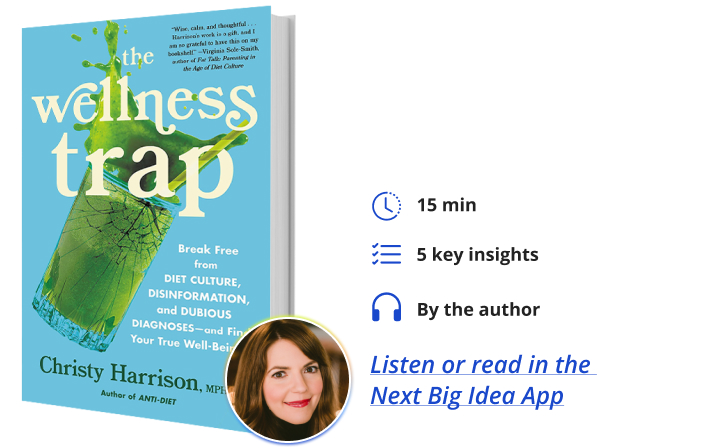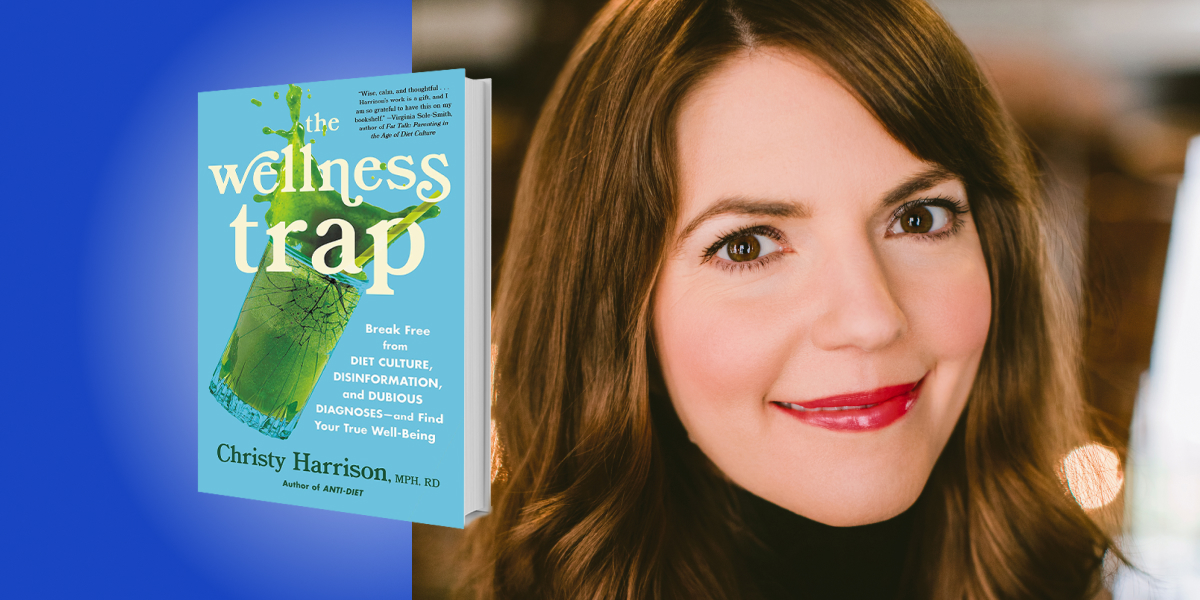Christy Harrison is a journalist and registered dietitian specializing in disordered-eating recovery, certified intuitive eating counselor, and journalist who writes about food and nutrition. She is the founder and host of the Food Psych podcast. Her writing has appeared in the New York Times, SELF, BuzzFeed, WIRED, Refinery29, Slate, and The Food Network.
Below, Christy shares 5 key insights from her new book, The Wellness Trap: Break Free from Diet Culture, Disinformation, and Dubious Diagnoses, and Find Your True Well-Being. Listen to the audio version—read by Christy herself—in the Next Big Idea App.

1. Pursuing wellness often leads to disordered eating.
There’s a common belief in wellness culture that being well means eating almost nothing but vegetables and protein—and of course, being thin. Many influencers and alternative- or integrative-medicine providers advocate cutting out a staggering array of foods—gluten, dairy, grains, anything processed, even certain vegetables—for supposed wellness.
But these restrictions often make people fear food and can lead to disordered eating habits. Cutting out food groups, limiting eating to small windows of the day rather than eating when you’re hungry, or otherwise overhauling your menu is a big deal for most people. Such a radical switch in diet can be a major life change that can affect your relationships and interfere with your ability to take pleasure or find spontaneity in food. There are serious side effects to dietary changes. When you’re following wellness culture’s diet rules, they can often start to take over your life.
This includes a woman named Erin, who has struggled with psoriasis and several other chronic conditions for many years. She started working with an alternative-medicine provider, who told her she was intolerant of sugar, dairy, and vegetables and fruits from the nightshade family, among many other foods. She started to see food as dangerous, and her diet became extremely limited. She cut out sugar completely for a few years, to the point where she was even making her own ketchup from scratch. She also was prescribed a long list of supplements and other treatments. At one point, she was taking at least twenty different supplements a day. Not only did she develop an eating disorder as a result of all this restriction, but her psoriasis didn’t improve at all; in fact, it got worse.
Diets like the one Erin was on generally don’t have good scientific evidence behind them. Even if they did, it’s incredibly difficult to stay on those diets long-term without damaging your relationship with food and your mental, emotional, and social well-being. If a way of eating detracts from those aspects of your life, can it even really be called wellness?
2. People who feel unheard or unserved by conventional medicine are especially susceptible to the harms of wellness culture.
Like too many people, Erin had had frustrating experiences with medical doctors who dismissed her concerns or didn’t seem to have time for her. She’d never gotten good treatment for her psoriasis, or for other conditions including migraines and severe chronic stomach pain. So when she started working with a naturopath, it felt like finally she was going to have someone listen to her and take her symptoms seriously. She had hope that she would finally figure out what was going on.
“One study found that supplements contribute to 23,000 emergency room visits every year, with more than 2,000 of those people (9 percent) going on to be hospitalized.”
Many people have similar reasons for being attracted to complementary, alternative, and integrative medicine. This industry accounts for a $413 billion segment, or about a tenth of the $4.4 trillion wellness industry. A 2017 report found that about half of Americans have tried some form of alternative medicine during their lifetime—about 20 percent have used it instead of conventional medicine, and about 30 percent have used it in addition to standard medical treatment. In a healthcare system where so many people feel like they’re being given one-size-fits-all treatments and not seen as whole people, it’s no wonder so many of us are interested in alternatives that purport to offer something different.
Unfortunately, though, alternative and integrative therapies are in many ways untested and unregulated. They can also be downright dangerous. Take herbal and dietary supplements, for example; supplements are legally prohibited from being tested for safety and efficacy before going to market in the U.S. That is a result of a 1994 law that was enacted thanks to significant supplement-industry lobbying.
Several studies have found that some supplements sold in popular nationwide vitamin chains may be adulterated with undisclosed pharmaceuticals and other drugs not listed on the label. This can include things like weight-loss supplements laced with synthetic amphetamines. Even when a supplement is found to be unsafe, FDA recalls and warning letters to manufacturers often don’t result in any changes; harmful products may remain on store shelves for months or years, with profoundly damaging effects. One study found that supplements contribute to 23,000 emergency room visits every year, with more than 2,000 of those people (9 percent) going on to be hospitalized.
Many people are wary of Big Pharma, sometimes with good reason (although sometimes those fears are being whipped up by someone trying to sell you something). But at least pharmaceutical drugs are regulated and required to be tested for safety and efficacy before going to market. With supplements, that’s simply not the case.
When you feel let down by the conventional healthcare system, you may think there’s no harm in trying supplements or other alternative, wellness-oriented treatments, which are framed as being natural, holistic, and gentle. Unfortunately, they’re not as harmless as they’re made out to be.
3. Wellness approaches can distract from the true cause of illness.
I interviewed a woman named Jennifer, who struggled for several years with digestive issues including constipation, bloating, and pain. Feeling frustrated by a lack of answers from conventional healthcare providers, she turned to a functional-medicine nurse practitioner, who put her on a strict diet and supplement regimen, believing her issues stemmed from a supposed gluten intolerance—a common belief in many corners of wellness culture.
At first, Jennifer felt heard and understood by this provider, but then she had another bad flareup of her digestive issues—except this time, she started experiencing a new kind of pain that was sharp and persistent. She mentioned this to the functional-medicine nurse practitioner, who chalked it up to systemic inflammation and said, essentially, that’s just how it goes.
“many supposedly “holistic” providers can get so laser‐focused on what they think is at the root of a person’s problem that they might overlook basic aspects of patient care and miss what’s actually going on for their clients.”
Feeling dismissed yet again, Jennifer sought out another provider—this time, a mainstream physician who specialized in digestive disorders. This new gastroenterologist actually did an abdominal exam—something the functional-medicine practitioner had never done—and thought maybe it was her gallbladder, so he sent her for an ultrasound the following day. What they found was far worse: it turned out to be a rare but aggressive type of tumor, located in her pancreas and interfering with critical blood vessels. She ended up having surgery the day before her 38th birthday, and the surgeon told her that if they hadn’t removed it, she wouldn’t have lived to see 45.
Of course, this is an extreme case, but Jennifer’s experience highlights a troubling issue with wellness approaches: many supposedly “holistic” providers can get so laser‐focused on what they think is at the root of a person’s problem—a food intolerance, a supposed fungal infection or parasite, a “leaky gut”—that they might overlook basic aspects of patient care and miss what’s actually going on for their clients. And that can have deeply damaging and even deadly consequences.
4. Social media algorithms facilitate the spread of wellness misinformation and disinformation.
Back in the early 2000s, while first dabbling in wellness approaches, alternative and integrative medicine were still on the fringes. Two decades later, they’ve exploded in popularity. Many wellness influencers have racked up millions of followers by promoting bizarre, non-evidence-based food restrictions and other out-there treatments. Celery juice is being hawked as a cure-all, people with perfectly normal blood sugar are being encouraged to wear continuous glucose monitors, and everyone is being made to fear gluten, even though celiac disease only affects one percent or less of the population.
Social media isn’t to blame for everything, but it does have a lot to do with the spread of these and other weird ideas about wellness. Even casually viewing or “liking” wellness influencers’ pages can cause sophisticated algorithms to serve up increasingly extreme diets and harmful practices. The algorithms are designed to maximize engagement—to keep us on the platforms for as long as possible so that we can be served more ads. Unfortunately, what does that best is novel and controversial information. That’s why extreme and unsubstantiated diet claims get amplified more than benign and commonplace posts about nutrition, leading users down rabbit holes of misinformation and disinformation. Recent reports have shown that teen girls who sign up for platforms like Instagram and TikTok that are seeking healthy-eating or weight-loss advice end up getting pushed to pro-eating-disorder content pretty quickly.
But it’s not just young girls who suffer—it’s all of us. Beyond even the algorithms, social media flattens sources of information, so that doctors and scientists are presented in very much the same way as an influencer speaking solely from their own experience. The influencer who has more followers lends them the appearance of trustworthiness. Sometimes it’s not even an influencer per se, but just a regular person whose testimonial about a certain wellness practice goes viral. There’s certainly nothing wrong with sharing personal experiences; it’s powerful and important in many instances. It can help others find connections and support that they aren’t getting from the healthcare system. In matters of wellness, however, it can be dangerous to model your own behavior on a social media personality whose only real evidence is “this worked for me.”
“Teen girls who sign up for platforms like Instagram and TikTok that are seeking healthy-eating or weight-loss advice end up getting pushed to pro-eating-disorder content pretty quickly.”
This flattening of information sources also creates a relativism that can easily be exploited by purveyors of mis- and disinformation. Not only does social media often give greater reach to influencers who may not know what they’re talking about, but it also places well-conducted scientific research on the same footing as anecdotes and non-peer-reviewed preprint studies. This then blurs them all together in one endless scroll. In the process, it can create the illusion that all of these sources are equally valid, which may allow false information to gain traction.
5. We can free ourselves from the wellness trap.
Lest this all sound too bleak, know that there are some helpful strategies for navigating wellness culture. Individual behavior alone is not enough to free us from the wellness trap. We need change at the cultural, institutional, and policy levels to help undo the harms of wellness culture and create a society that truly supports well‐being for everyone. As an individual though, there are a number of actionable things you can start doing right now to help keep from getting ensnared in the wellness trap.
One is to try to approach alternative and integrative medicine, and the wellness industry in general, with as much critical thinking and skepticism as you would conventional medicine. Don’t assume that alternative medicine or supplements are any less problematic and profit-driven than their conventional counterparts. This goes even if they’re framed as being “natural” or “holistic.” In many cases, wellness recommendations are based on claims that are highly speculative or downright false. It’s completely understandable to want relief from symptoms, and to feel unheard or underserved by the conventional healthcare system—but remember that the wellness industry capitalizes on those feelings.
To help get back in touch with your natural skepticism, consider taking a step back or even a full-on break from social media, and recognize how it pushes us toward increasingly extreme content that isn’t necessarily backed by good evidence. You might reflect on how social media pulled you down rabbit holes you hadn’t planned on visiting. You can also spend some time getting back in touch with your own deeply held beliefs and values, without the influence of algorithms.
In addition to setting limits on technology, it can be helpful to set boundaries with the people in your life. This may include, perhaps, conveying to any wellness‐culture adherents in your life that you love and support them, but that you’re on a different path. If friends and family members can’t stop talking about their latest wellness plan, candida cleanse, or autoimmune protocol, you might share with them that those types of things have been harmful to you. You can also express that you would rather not discuss the topics of health and wellness.
Finally, when you do come across wellness information online, you can use a method called SIFT, developed by a researcher at the University of Washington named Mike Caulfield, who studies digital media literacy. SIFT stands for its four steps:
- Stop.
- Investigate the source.
- Find better coverage.
- Trace claims, quotes, and media to the original context.
SIFT is meant to help people think twice before reflexively sharing or acting upon unverified information. The process involves quickly moving away from the actual content of the misinformation and focusing on the context so that you’re not wasting precious time trying to dissect dubious sources. “The goal of disinformation is to capture attention, and critical thinking is deep attention,” Caulfield wrote in 2018. “Whenever you give your attention to a bad actor, you allow them to steal your attention from better treatments of an issue, and give them the opportunity to warp your perspective.” So instead of doing a deep dive into misinformation to try to understand it from the inside—which is what we might traditionally view as critical thinking—you’re better off seeking out other, more credible sources to put the information into context.
To listen to the audio version read by author Christy Harrison, download the Next Big Idea App today:































